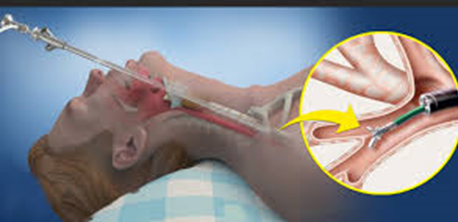A nurse is reinforcing teaching with a client who is scheduled to undergo a bronchoscopy. Which of the following client statements indicates an understanding of the teaching?
"I can have clear liquids up to 3 hours before the procedure."
"I can eat as soon as the procedure is completed."
"I will receive an injection of radioactive material prior to having the procedure.”
"I might have blood-tinged sputum after the procedure."
The Correct Answer is D
Choice A Reason:
"I can have clear liquids up to 3 hours before the procedure." This is incorrect. Clients are usually instructed to be NPO (nothing by mouth) for a certain period before the procedure, typically 6-8 hours, to reduce the risk of aspiration.
Choice B Reason:
"I can eat as soon as the procedure is completed." This is incorrect. Clients should not eat or drink until the gag reflex returns, which can take a few hours after the procedure.
Choice C Reason:
"I will receive an injection of radioactive material prior to having the procedure.” This is incorrect. An injection of radioactive material is not part of a bronchoscopy. This might be confused with a different diagnostic procedure, such as a PET scan.
Choice D Reason:
"I might have blood-tinged sputum after the procedure." This statement indicates an understanding of the teaching. It is common for clients to have a small amount of blood-tinged sputum following a bronchoscopy due to the irritation caused by the procedure.

Nursing Test Bank
Naxlex Comprehensive Predictor Exams
Related Questions
Correct Answer is C
Explanation
Choice A Reason:
Discarding soiled wound care supplies in a trash receptacle outside the client's room is generally a good practice for infection control. However, this action alone might not be sufficient for managing an infectious wound. Proper disposal is essential, but placing the client in isolation is more critical to prevent the spread of infection.
Choice B Reason:
Administering antibiotic therapy before culturing the wound might interfere with accurate culture results. It's generally preferred to obtain wound cultures before starting antibiotic therapy to identify the specific pathogens causing the infection and determine the most effective treatment.
Choice C Reason:
Placing the client in a private room with a private bathroom is correct. Isolating the client in a private room with a private bathroom helps minimize the spread of potential pathogens present in the wound drainage. This measure helps contain the infection and prevents exposure to others.
Choice D Reason:
Instructing visitors to perform hand hygiene for only 5 seconds after leaving the client's room isn't thorough enough for proper infection control. Proper hand hygiene typically involves washing hands with soap and water or using alcohol-based hand sanitizer for at least 20 seconds to effectively reduce the spread of infection.
Correct Answer is D
Explanation
Choice A Reason:
Setting the degree of flexion and extension as tolerated by the client is generally appropriate in a CPM device, but this should be done within the prescribed range recommended by the healthcare provider. Simply allowing the client to adjust the degree of flexion and extension without guidance might lead to overextension or inadequate movement, potentially causing discomfort or hindering recovery.
Choice B Reason:
Padding the CPM device with a thick pillow isn't the recommended approach. CPM devices typically come with appropriate padding to ensure comfort and proper positioning. Using a thick pillow might alter the device's mechanics or cause uneven support, affecting the intended movement of the knee.
Choice C Reason:
Placing the client in high-Fowler's position (sitting upright at a 90-degree angle) isn't a standard or necessary position for using a CPM device after a knee arthroplasty. The client can typically use the CPM device while lying in a comfortable and relaxed position, following the healthcare provider's instructions regarding positioning during CPM therapy.
Choice D Reason:
Aligning the client's joints with the joints on the frame is essential for the correct function of the CPM device. This alignment helps in providing the intended range of motion without causing unnecessary stress or strain on the knee joint.

Whether you are a student looking to ace your exams or a practicing nurse seeking to enhance your expertise , our nursing education contents will empower you with the confidence and competence to make a difference in the lives of patients and become a respected leader in the healthcare field.
Visit Naxlex, invest in your future and unlock endless possibilities with our unparalleled nursing education contents today
Report Wrong Answer on the Current Question
Do you disagree with the answer? If yes, what is your expected answer? Explain.
Kindly be descriptive with the issue you are facing.
